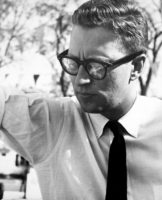Each year at the Salone del Mobile in Milan, the Italian magazine Interni engages international architects and designers for temporary exhibits that become spaces for experimentation. Working off the theme "Energy for Life" of the Expo Milano 2015 (opening May 1), this year Interni presents "Energy for Creativity" at the University of Milan. Within the many courtyards of the sprawling university complex, built beginning in 1456 as a hospital, are large-scale installations by the likes of Daniel Libeskind, Alessandro Mendini, and Philippe Starck (though if you didn't know it, you'd miss his contribution—a beverage cart).
Libeskind, who has a large office in Milan, is a regular participant at the Salone. "This week in Milan is a chance to look at architecture and design in a free way," he says. "No city in the world has this type of event that's open to the public."
His installation, a celebration of color and straight lines called "Future Flowers," is set within what's known as the Pharmacy Courtyard. The folded and cut metal panels are painted in a red color Libeskind developed for Italian paint manufacturer Oikos. "We created a palette of 33 of my own colors with a unique, solvent-free and sustainable chemistry," he says. "I'm painting my apartment with these colors—it's the first time since I was a student that I'll be living in a space without white walls."
Tokyo and Paris-based architect Kengo Kuma also has an annual presence at the Salone. This year, he was invited by Japanese kitchen manufacturer Kitchenhouse, for whom he designed a Shanghai showroom, to create an exhibit outside the university's grand hall. Based on the traditional Japanese hearth, or Irori, Kuma made what he refers to as fire and cocoon.
"The fireplace used to be the center of the home," Kuma explains. "In the 20th Century, rooms got divided in an unhealthy way. I want to combine the traditional and the new in an open space."
Made from 1mm-thick vulcanized paper, Kuma's cocoon of twisting and weaving strips was developed on the computer but built by hand. The long white, cloud-like structure, which supports itself, encases a space where a low fireplace, kitchen, and dining area flow into each other.
Exhibiting for the first time in Milan, New York-based architects Steve Blatz and Antonio Pio Saracino created "Black Hole." Composed of steel, glass, and wood (provided by sponsors Marzorati Ronchetti, Vetreria Bazzanese, and Zordan) their small tower is meant to be a "creative balance of chaos and order," according to Blatz. Within the perfectly round form, visitors can recline on the sinuous wood seating at the base to gaze up through the oculus, composed of irregularly-shaped, overlapping wood discs.
Milan-based architects Antonio Citterio and Patricia Viel created four towering pillars—each 33-feet high—whose three long sides are sheathed in Dekton tiles that are engraved with texts from literature and philosophy. "The tiles seem like normal ceramic, but in reality they are made using a new process that gives them not just a surface, but a thickness," Citterio explains. "So we incised words into them to express the material."
A smaller installation by Raffaello Galiotto of intricate marble objects demonstrates the possibilities of that material when manipulated by diamond disc and wire cutting. Other standouts include a ribbon of mirror walls by Russian architects Speech Tchoban & Kuznetsov with Agniya Sterligova in the middle of the large, central courtyard, and telescoping pavilions by Annabel Karim Kassar Architects in a small courtyard at the opposite end of the complex.
The exhibit is on view until May 24.























Post a comment to this article
Report Abusive Comment